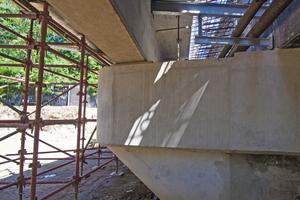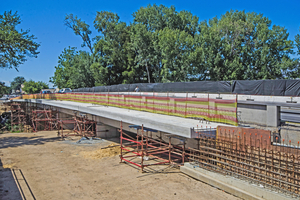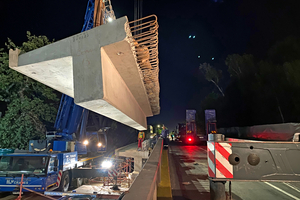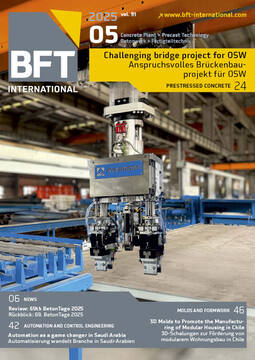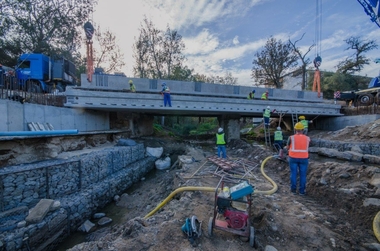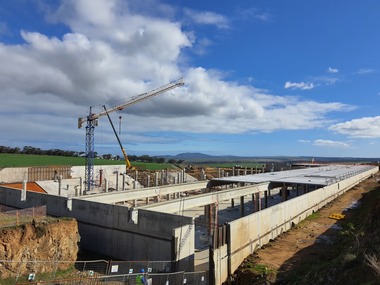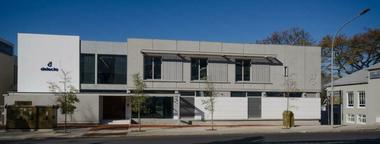Historic Ceres Bridge widened with Precast Concrete
First built in 1928 to span the Dwars River in Ceres, South Africa, the historic Van Breda Bridge has been widened by Amandla Construction. Completed in 2024, the project entailed the addition of new pedestrian walkways and wider traffic shoulders on either side of this twin-lane gateway to the town centre. In addition to the widening process, the original concrete deck was reinforced to handle heavier traffic loads in compliance with current design codes.
The revamped structure was designed by Ingerop South Africa in association with Mowana Engineers. Concrete Manufacturers Association member, Cape Concrete Works, manufactured the precast concrete T-beams, which were used to replace the old steel and wood walkways. Appointed by the Witzenberg Municipality as the employer’s agent in 2018, Ingerop managed the tender and procurement processes and was responsible for project administration and overseeing construction.
The new walkways were to have been initially constructed in-situ as the original bridge had been, however, as an alternative, Amandla advised using precast beams, a proposal which was accepted by Ingerop. “It offered quicker construction times and caused less environmental damage,” said Ingerop engineer, Jameel Pathan. “Not requiring extensive shoring, shuttering or scaffolding, it made the construction programme easier to achieve.”
The bridge comprises a six-pier/seven-span structure and the walkways and widened roadway required the installation of 14 precast T-beams, seven apiece on either side, a process which also necessitated the widening and reinforcement of the existing piers and abutments.
Amandla widened the piers by breaking into the bull-nose ends and doweling with Y25 rebar on two levels to create corbels at either end. In addition, their upper sections were bulked up with additional concrete and reinforced with post-tensioned cabling. Moreover, each abutment was extended by 2m on either side. They were built on piles which were sunk to a depth of 5m to 8m and were connected to the existing abutments with doweled reinforcing.
Each of the 14 beams with own dimensions
The main challenge in installing precast beams was that each of the 14 beams has its own dimensions. One reason for this was that the existing bridge deck was not flat. Instead, it rose in a shallow arch from each end reaching its apex at the bridge’s mid-point, and this feature had to be duplicated with the precast beams in the new structure. This meant that the beams had to be laid at the same angle as the original deck and the longitudinal face or outer rim of each beam had to be manufactured with a slight curve to achieve the arched configuration.
The other factor concerned the angling of the beam ends. The bridge deck crosses the river diagonally but the piers were erected in line with the river course, and this placed them at a diagonal to the bridge deck. This meant that Cape Concrete could not cast the beam ends conventionally at 90° to the longitudinal sides, but had to adjust them parallel to the piers on which they rested. Moreover, because the beams don’t lie flat but are inclined to form the arch, the ends also had to be adjusted to achieve a perpendicular elevation to the horizontal line. Mounted with only a 30mm gap between them, the front end of one beam had to match the back end of the adjacent beam.
After delivery to site the beams were lowered onto the bearing plinths by two mobile cranes. Cast on the pier extensions, Amandla had to calculate the angle of the plinths to enable the beams to rest in line with the existing structure. The plinths measure 1.5m x 750mm, and depending on pier height and the required beam angles, were cast in thicknesses which varied between 30mm and 150mm to achieve the required slopes.
As with the original bridge, malthoid sheeting was placed between the beams and the plinths to allow for beam movement caused by thermal and loading variations. The beams are linked at surface level by steel claw joints which allow for expansion and contraction.
All beams were cast with a single mould
Although the beams only span 13.5m, they weigh 65 tonnes apiece because of their cross-sectional T-shaped design. They have a deep 1.35m beam section and a 3m wide top flange section which tapers from one end to the other. They were cast with normal reinforced concrete to a strength rating of 40MPa, and because of their cross-sectional design and relatively short spans, prestressing was not required.
“We tried to keep the beam design as simple as possible,” said Mowana’s design engineer and director, Edward Smuts,” and we designed a typical beam which would fit all seven spans. This meant that all 14 beams could be cast with a single mould; the only adjustments needed were at the upper level to accommodate the curve of each beam, and at the end plates, to achieve the correct beam-end angles.
“Each beam had a unique curve formation which determined its thickness and the concrete cover above the reinforcing. The centre beams, which lie between the third and fourth piers, are at their thickest at mid-point and taper towards each end. The other beams are also tapered from end-to-end to achieve the necessary curves. Moreover, beam lengths vary slightly because the original bridge was built with small inconsistencies and these were managed in the casting process by Cape Concrete.”
In order to cast the beams accurately Cape Concrete had the arches on either side of the original structure surveyed. “We logged all the surveyed levels onto diagrams, plotted all the beams in their different positions and transferred the levels to each beam so that when they were installed they formed the two arches on either side of the bridge. The mould was assembled to accommodate the thickest slab and we simply under-filled it for the thinner slabs,” said Cape Concrete director, Johan Nel.
“Before casting, the mould was adjusted to each beam’s dimensions and we used chamfers to create the curves at the top of the beams on both sides of the mould. We measured the space between the soffit and the top of the beam at metre intervals to align the chamfers for the desired curve structure in each beam. Furthermore, we adjusted the end plates before casting to achieve the correct vertical and horizontal angles. We had to be very precise with the end plate adjustments because a 30mm gap between the beams of this size is a very tight joint and maintaining our tolerances was critical. For example, we could be accurate at the bottom of the mould but if the angle was slightly out, say by 10mm out on either side, all of a sudden the gap is 50mm. Therefore we had to check our measurements very carefully before casting. We were not always 100% accurate but we were always within acceptable tolerances.”
Traffic lanes must remain open at all times
Cape Concrete cast the beams with three layers of protruding rebar. Two layers, one of Y16 at the bottom and the other Y20 at the top, protruded laterally from the inner beam face and the third protruded vertically for the installation of in-situ parapets which were cast between the road shoulders and the walkways. The two lateral rebar sections were spliced with rebar which was doweled into the existing structure by Amandla. After further reinforcing and shuttering, concrete was poured to create infill slabs which once set, formed a permanent connection between the old bridge deck and the new walkways.
The old 250mm deck was strengthened by an addition of 150mm of reinforced concrete and by bolting steel plates to the soffits and sides of the original in-situ beams. Jameel Pathan says that one of the other project challenges is that both traffic lanes must remain open at all times and some complicated programming had to be done to achieve this objective.
“This means that when one side of the deck was reinforced traffic was diverted onto the new walkways which were designed to handle heavy traffic as well as pedestrian loads,” concluded Pathan. The revamped structure still carries one lane of traffic in either direction but each has yellowed-lined shoulders abutting the parapets and in-situ cast balustrades on the outer edges of the bridge.
Text: David Beer
CONTACT
Cape Concrete Works
Wimbledon Rd., Blackheath 7580
Cape Town/South Africa
+27 21905 1200
(in association with Mowana Engineers)


